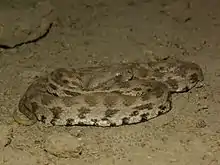Macrovipera
Macrovipera is a genus of venomous vipers that inhabit the semideserts and steppes of North Africa, the Near and Middle East, and the Milos Archipelago in the Aegean Sea.[1] These snakes are responsible for a number of bites in Africa and Western Asia every year. They have a reputation for being ill-tempered and can inject a lot of venom, which is why they should be considered as very dangerous.[3] Three species are currently recognized.[4]
| Macrovipera | |
|---|---|
 | |
| Macrovipera lebetinus obtusa | |
| Scientific classification | |
| Kingdom: | Animalia |
| Phylum: | Chordata |
| Class: | Reptilia |
| Order: | Squamata |
| Suborder: | Serpentes |
| Family: | Viperidae |
| Subfamily: | Viperinae |
| Genus: | Macrovipera A.F. Reuss, 1927[1] |
- Common names: large Palearctic vipers.[2]
Description
Except for M. schweizeri, these snakes are all capable of exceeding 1.5 m (4.9 ft) in total length (body + tail).[3]
The head is broad, flat, and distinct from the neck. Dorsally, it is covered with small, irregular keeled scales. The supraoculars are also fragmented or partially divided. There seems to be a lot of variation in the different scale characteristics.[3]
Geographic range
Species of this genus are found in Morocco, Algeria and Tunis in North Africa, east to Pakistan, Kashmir and India, north to the Milos Archipelago in the Azerbaijan, Aegean Sea (Greece), Armenia and Dagestan (Russia). To the south, there is only one old record from Yemen.[3]
Species
| Species[1] | Taxon author[1] | Subsp.* | Common name | Geographic range[1] |
|---|---|---|---|---|
| M. lebetinusT | (Linnaeus, 1758) | 4 | Blunt-nosed viper | Dagestan, Algeria, Tunisia, Cyprus, Turkey, Syria, Lebanon, Iraq, Iran, Russian Caucasia, Armenia, Georgia, Azerbaijan, Turkmenistan, Uzbekistan, Kazakhstan, Tadzikhistan, Afghanistan, Pakistan and Kashmir. |
| M. razii | Oraie, Rastegar-Pouyani, Khosrovani, Moradi, Akbari, Sehhatisabet, Shafiei, Stumpel, & Joger, 2018 | 0 | Razi's viper | Iran (Kerman) |
| M. schweizeri | (F. Werner, 1935) | 0 | Milos viper | The Grecian islands of the Cyclades Archipelago in the Aegean Sea: Milos and the three smaller, adjacent islands of Siphnos, Kimolos and Polinos. |
*) Not including the nominate subspecies.
T) Type species.
Taxonomy
The genus Macrovipera was created by Francis Albert Theodor Reuss (1927), specifically to accommodate M. lebetinus (the type species). The three other species currently recognized were, at one point, all regarded as subspecies of M. lebetinus. It is now likely that certain subspecies of M. lebetinus will also be elevated to valid species status in the not too distant future.[3] Regarding the geographic range of M. lebetinus, it is possible that this species is now extinct in Israel.[5]
Various species of this genus (and likewise of Vipera) have been suggested for inclusion in the genus Daboia instead, in particular M. lebetinus (Obst 1983) as well as M. mauritanica and M. deserti (Lenk et al. (2001).[6]
References
- McDiarmid RW, Campbell JA, Touré T. 1999. Snake Species of the World: A Taxonomic and Geographic Reference, Volume 1. Washington, District of Columbia: Herpetologists' League. 511 pp. ISBN 1-893777-00-6 (series). ISBN 1-893777-01-4 (volume).
- Spawls S, Branch B. 1995. The Dangerous Snakes of Africa. Dubai: Ralph Curtis Books. Oriental Press. 192 pp. ISBN 0-88359-029-8.
- Mallow D, Ludwig D, Nilson G. 2003. True Vipers: Natural History and Toxinology of Old World Vipers. Malabar, Florida: Krieger Publishing Company. 359 pp. ISBN 0-89464-877-2.
- "Macrovipera". Integrated Taxonomic Information System. Retrieved 5 August 2006.
- Macrovipera lebetinus at the Reptarium.cz Reptile Database. Accessed 9 August 2007.
- Lenk P, Kalyabina S, Wink M, Joger U (April 2001). "Evolutionary relationships among the true vipers (Reptilia: Viperidae) inferred from mitochondrial DNA sequences". Molecular Phylogenetics and Evolution. 19 (1): 94–104. doi:10.1006/mpev.2001.0912. PMID 11286494.
Further reading
- Reuss [AF]T. 1927. Sechs europaïsche Giftschlangengattungen. Zoologischer Anzeiger 73: 124-129.
- Obst FJ (1983). "Zur Kenntnis der Schlangengattung Vipera". Zoologische Abhandlungen. Staatliches Museums für Tierkunde in Dresden. 38: 229–35. (in German).
External links
| Wikimedia Commons has media related to Macrovipera. |